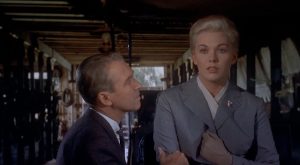
 Over the next two months, Film Forum is showing the complete films of both Alfred Hitchcock and Francois Truffaut. In honor of this pairing, we will preview the Hitchcock films using insights from the directors’ own conversations in Hitchcock/Truffaut, Truffaut’s landmark book of interviews.
Over the next two months, Film Forum is showing the complete films of both Alfred Hitchcock and Francois Truffaut. In honor of this pairing, we will preview the Hitchcock films using insights from the directors’ own conversations in Hitchcock/Truffaut, Truffaut’s landmark book of interviews.
This Friday and Saturday, Film Forum is giving you the chance to see “Vertigo” on the big screen, the only way it deserves to be seen. Despite being released at the height of Hitchcock’s fame, the film was initially a commercial failure, but the years since have been very kind to it’s reputation – last year, it ended the fifty year reign of “Citizen Kane” in the top spot on Sight and Sound’s list of the best films of all time.
An elusive tale of obsession and desire, “Vertigo” tells the story of Scotty Ferguson, an ex-San Francisco cop, who left the force due to his crippling fear of heights. An old friend asks him to tail his wife Madeline, whom he describes as crazy and suicidal. Scotty falls in love with his quarry and though he is able to save her life once, his vertigo prevents him from saving her a second time, driving him into a spiral of guilt and depression. When Scotty thinks he’s recovered, he meets Judy, a woman on the street who looks exactly like Madeline. He tries to remake her into the image of the dead woman, not suspecting until the end that he has been a pawn in a murder plot and Judy and Madeline are one and the same, and destined for the same fate.
Truffaut and Hitchcock’s discussion of “Vertigo” includes both practical explanations of some of the scenes and talk about the twisted character psychology. Truffaut tells an unaware Hitchcock that the French authors of the source novel wrote it specifically hoping that he would purchase the movie rights. Hitchcock says that he wasn’t interested in the thriller aspect, which he rearranged in the movie version, but by “the hero’s attempt to re-create the image of a dead woman through another one who’s alive.” The idea of a man trying to create his ideal woman is as old as the Greek myth, but the twist here is that the man’s ideal woman has already died (he thinks). As Hitch says, “to put it plainly, the man wants to go to bed with a woman who’s dead; he is indulging in a form of necrophilia.” There is an additional dreamlike displacement of identity in the fake Madeline’s obsession with the suicidal Carlotta Valdez; she spends hours gazing into Carlotta’s eerily similar portrait before committing suicide in the same fashion. Jimmy Stewart’s Pygmalion act reaches its crazed apex in the scenes when he is shopping with Judy, forcing her to buy the same clothes as Madeline and wear her hair in the same way. Hitchcock tells Truffaut that “all of Stewart’s efforts to re-create the dead woman are shown in such a way that he seems to be trying to undress her.”
For the aspiring filmmakers out there, their talk also details Hitchcock’s creation of the famous “Vertigo” effect – the combination of track-out shot with a forward zoom. Hitch says that he initially conceived of it during a drunken night at the Chelsea Arts Ball. He tried to get it into “Rebecca,” but had to wait almost twenty years to get the right chance. Even then, his crew told him it would cost fifty thousand dollars to execute, due to the difficulty of holding the camera above the stairway. Since there were no characters in the shot, they compromised by building a miniature stairway and shooting it horizontally, which still ended up costing nineteen thousand dollars (in 1958 dollars).